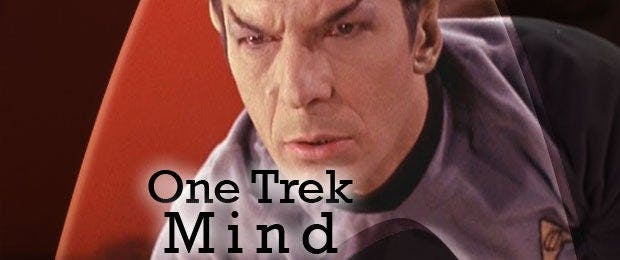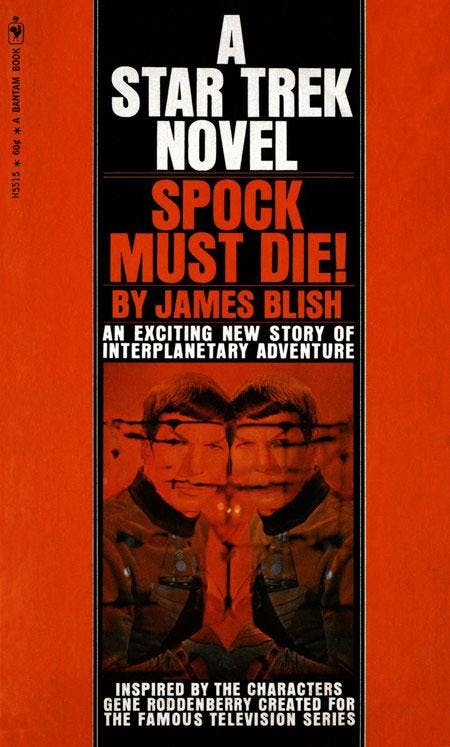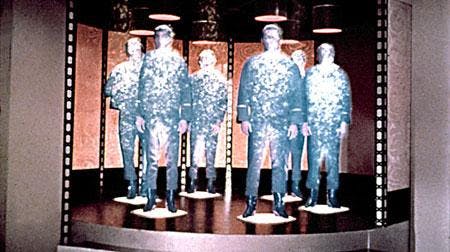Published Feb 20, 2013
One Trek Mind: 10 Facts About First Trek Tie-in Novel
One Trek Mind: 10 Facts About First Trek Tie-in Novel

On the subject of Star Trek tie-in novels I am, compared to some hardcore fans, a mere cadet. Next to the average citizen, however, I am a Mr. Atoz-level scholar. While I've read and enjoyed a number of Trek novels, I've reached a point in my life where I can accept that I will never read them all. (Or ever, for that matter, know just how many are out there – even locking down this seemingly knowable number through quick Internet research has a quantum-like quality to it. Call it Schrodinger's Novel.)

A few days ago, however, I decided to warp back to Sector 001, to where it all began, and read “Spock Must Die!,” the first ever Star Trek tie-in fiction. Here are 10 things you should know.1 - It actually isn't the first ever Star Trek tie-in fiction. Star Trek comics began in 1967, but the first licensee (Gold Key) produced “Trek in name only.” The original artists had never seen the show and the tone is basically “Buck Rogers with a Pointy-Eared First Officer.” A book aimed at kids called “Mission to Horatius” was published in 1968. (It went out of print but a “facsimile copy” was made available by Pocket Books in 1999.) Also, short story adaptations of the episodes commenced in 1967, the early ones based off of the show's scripts. So for you Trek fans who love to get technical (e.g. all of you) “Spock Must Die!” is not really the first.2 – The author of those short stories, James Blish, got the nod to do the first novel “for all readers” after the series was cancelled. “Spock Must Die!” was released in 1970 and included a forward imploring that fans to rally around the show in the hopes that it may be revised.3 – Blish was no joke of a choice. The Hugo Award winner was a man with real sci-fi bonafides, having written some memorable stories and novels in the 1950s and 60s. Best known are the “Cities in Flight” books, which feature giant antigravity devices called Spindizzies. If you've ever stayed up late in your parents' basement staring at the cover of the first Boston album, that is an artistic rendering of a Blish Spindizzy.

4 - “Spock Must Die!” is a fun (and quick) read. The basic plot is this: the Klingons have figured a workaround to the enforced Organian Treaty. The Enterprise wants to check up on the Organians, but a large distance between them (more on this in a moment) forces Scotty to come up with a workaround. He projects a transporter-created Tachyon version of Spock to Organia, but the process backfires, creating TWO SPOCKS!5 – There is a surprising amount of lip service paid to actual science in “Spock Must Die!” Or, if at least not actual science, then at least conversation about what deep space exploration may actually be like. The main two examples seem to emerge from late night ruminations about the show's future tech.
Regarding the transporter, “Spock Must Die!” opens with a rather philosophical discussion between Dr. McCoy and Scotty about the transporter's projection of what are, essentially, duplicates of matter. What, then, becomes of a person's “soul”? This is expanded upon after the accident, when a quantum-derived Spock (later shown to be evil) appears. Is disposing of him murder?

Also: interstellar distance. In every iteration of Star Trek, the ship zooms off to the planet by the next commercial break. In “Spock Must Die!,” a journey from the edge of the Neutral Zone to Organia takes months. Plenty of time to dig in and jaw about the problems at hand, but this is something you never see on the show.Lastly, Blish makes references to Hilbert Space, and goes deep on warp theory and ideas about tachyons. I'm not enough of an expert to know what's true and what's jive, but I like the fact that it is there.6 – For a first book (and one made before the films), the characters feel pretty true. Blish leans hard on McCoy being a psychiatrist, Spock being pure calculation and Kirk making strong decisions and standing by them. However, there's also a weird attitude toward women in the book. In true Roddenberry form, they are given responsibility and treated with a degree of respect (especially considering the time), but a conversation between Kirk and McCoy about “how the women will react to two Spocks” and Uhura's wish that a newcomer “is cute” seems mismatched.7 - “Spock Must Die!” has a fetish for literature, basing an entire plot point about the stream-of-consciousness “Eurish” language found in James Joyce's “Finnegan's Wake.” Uhura even uses her interpretation of this language as an unbreakable code. Also, for those paying close attention, there's a Mervyn Peake reference – a list of dangerous alien species includes “Gormanghastlies.”8 – Blish didn't get the memo (or the memo didn't exist yet) that Trek books had to “leave everything where they found it.” As such, the story ends with some definitive changes made toward the Klingons. The Organians leave them “grounded” - not just pre-warp, but unable to make any spaceflight, for one thousand years. Also, Koloth is essentially done away with. He is trapped in a fourth dimensional loop – and what's worse is that he doesn't even know it.

9 - “Spock Must Die!” is philosophical when you least expect it. In addition to McCoy's worries about transporter-projected souls, there's this chestnut: “If the Universe were shrinking at the rate of a centimeter a day, and all our measuring rods were contracting with it at the same rate, could we even suspect that anything was happening?” Far out, Blish. Far out.10 – There were six years between “Spock Must Die!” and the next Star Trek books. (1976 saw the first collected “fan fiction” stories called “The New Voyages” with introductions from the cast, followed by “Spock: Messiah,” the next proper novel.) For a while, it may have seemed that Blish's final paragraphs were the final word on the exploits of the USS Enterprise. As I'm not much of a fan of “Turnabout Intruder,” I must confess that this would have been a better note to go out on.Do you have a chewed-up mildewy copy of “Spock Must Die!” in your basement? Has this column inspired you to buy one off of Amazon for one penny? Let me know your thoughts below.
_______________________________
Jordan Hoffman is a writer, critic and lapsed filmmaker living in New York City. His work can also be seen on Film.com, ScreenCrush and Badass Digest. On his BLOG, Jordan has reviewed all 727 Trek episodes and films, most of the comics and some of the novels.

